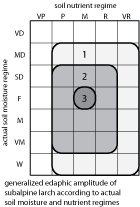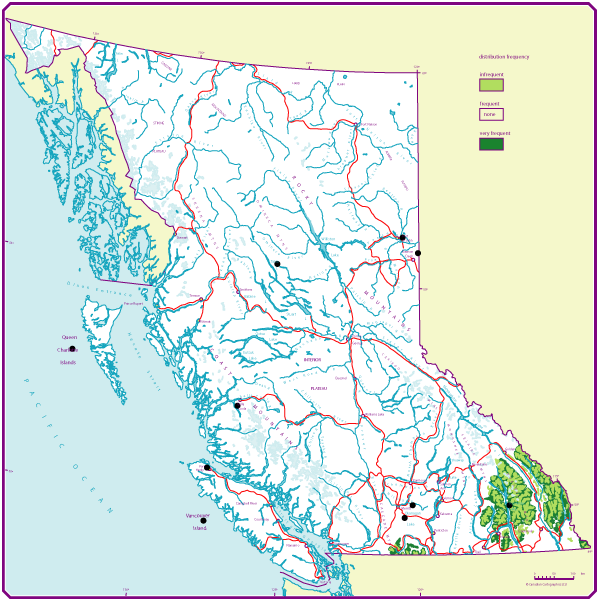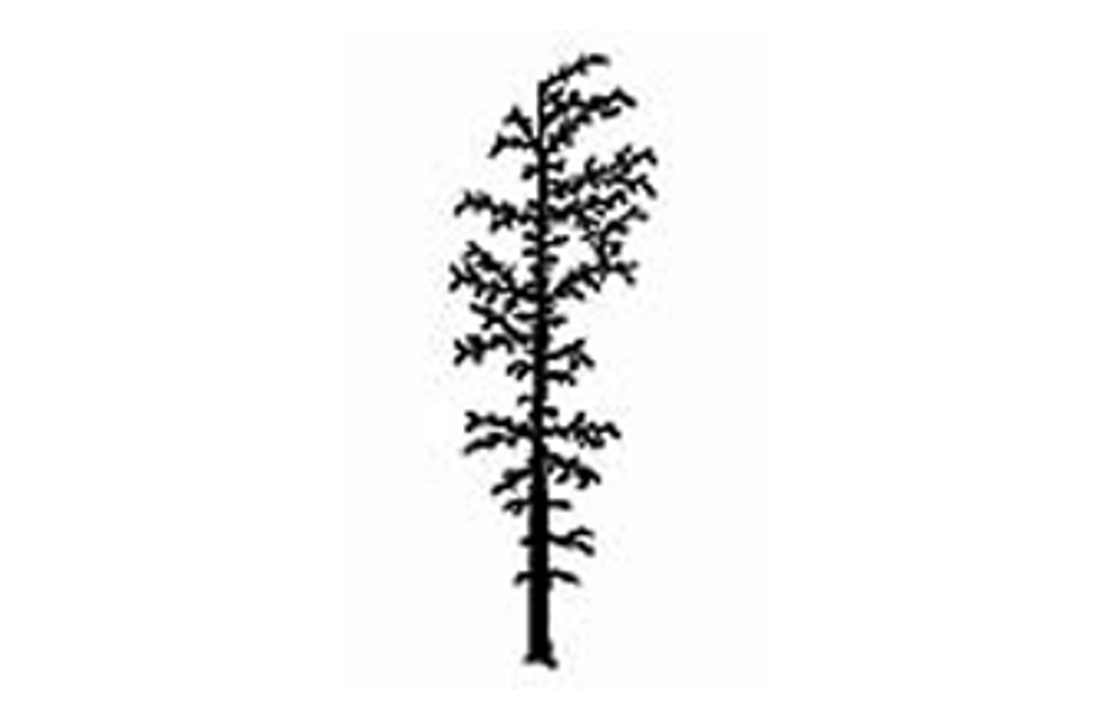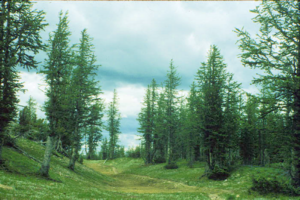Subalpine larch
On this page
- Geographic range and ecological amplitudes
- Tolerances and damaging agents
- Silvical characteristics
- Genetics and notes
Geographic range and ecological amplitudes
Description
Subalpine larch, also called alpine larch, is a small- to medium-sized (rarely >30m tall), deciduous conifer, with a short, sturdy, and tapering stem; ragged, broad irregular crown; and yellowish-gray bark, with irregularly shaped, scaly plates. It is an ecologically interesting and aesthetically attractive species but its wood has little commercial value.
Geographic range
Geographic element
Distribution in Western North America:central in the Cordilleran region
Ecological amplitudes
Climatic amplitude:
(alpine tundra) - subalpine boreal
Orographic amplitude:
subalpine - (alpine)
Occurrence in biogeoclimatic zones:
(lower AT), upper - (lower) southern ESSF
Subalpine larch is well adapted to a continental subalpine boreal climate. It grows in the transition between the upper southern portion of the ESSF zone and the adjacent AT zone between 1800m and 2300m. It forms a timberline there together with subalpine fir, (Engelmann spruce), and whitebark pine. It tolerates very severe winters (the absolute minimum of -56 degrees C has been recorded). Occasional chinook winds of very dry air during the winter rarely affect subalpine larch to a lethal degree because of its deciduous habit, while evergreen conifers may be severely affected because moisture lost rapidly from foliage cannot be replaced.
Edaphic amplitude

Range of soil moisture regimes:
(moderately dry) - slightly dry - fresh - moist - very moist - (wet)
Range of soil nutrient regimes:
poor - medium - rich - (very rich); calciphytic
The nutrient amplitude of subalpine larch is not well known. Field studies indicate that it is absent on very poor sites and grows somewhat better on calcium-rich substrates, such those derived from calcareous quartzites, sandstones, or argillites. However, very rapidly drained limestones are less favorable substrates in drier climates than other sedimentary and igneous rocks.
Tolerances and damaging agents
Root system characteristics
The root system of grand fir is intermediate in development among its associated tree species. The anchoring taproot does not grow as rapidly nor as deeply as it does in ponderosa pine, common douglas, and lodgepole pine, but it grows faster and deeper than in western hemlock, western redcedar, and Engelmann spruce. Seedlings roots penetrate the soil rapidly enough in full sunlight (slower under shaded conditions) to survive drought conditions in forest floor and surface mineral soil. A relatively deep taproot enables grand fir to survive and grow well on rather dry soils and exposed ridges. On moist sites, the taproot is largely replaced by more shallow lateral roots. Grand fir roots are associated with both ecto- and endo-mycorrhizae.
| Tolerance to | Tolerance class | Comments |
|---|---|---|
| Low light | L – M | Moderately tolerant in dry climates, intolerant in wet climates. |
| Frost | L – M | Low in coastal populations, medium in interior populations; frost cracks are common. |
| Heat | M | Protection-requiring on warm and dry sites. |
| Water deficit | M | Protection-requiring on dry and warm sites. |
| Water surplus | H | Frequent on floodplains, infrequent on wet sites, frequent on sites with a strongly fluctuating water table. |
| Nutrient (mainly N) deficiency | M | Absent on very poor sites, infrequent on poor sites. |
| Damaging agent | Resistance class | Comments |
|---|---|---|
| Snow | M | Infrequent in high snowfall areas. |
| Wind | M | Low resistance when exposed by heavy partial cuts. |
| Risk class | ||
|---|---|---|
| Fire | H | Wildfires are frequent in dry temperate climates of southern B.C. |
| Insect | H | Balsam woolly adelgid, western spruce budworm, Douglas-fir tussock moth. |
| Fungi | H | Laminated root rot, Armillaria root disease, and Indian paint fungus. |
Associated tree species and successional role
In British Columbia, grand fir grows prevailingly as a scattered, minor species in combination with one or more tree species. Pure old-growth stands of grand fir are rare. It is present in early, intermediate, and late stages of secondary succession; a minor component in old-growth stands in the CDF, southern IDF, ICH, and CWH zones.
| Associated tree species |
Occurance class | Major area of occurance |
|---|---|---|
| Western redcedar | L | Southwestern and southeastern B.C. |
| Pacific silver fir | L | Southern submaritime wetter CWH |
| Subalpine fir | L | Montane southeastern B.C. |
| Red alder | L | Submontane southwestern B.C. |
| Black cottonwood | L | Floodplains in southwestern and southeastern B.C. |
| Common douglas | L | Southwestern and southeastern B.C. |
Genetics and notes
Genetics
There are no recognized varieties of grand fir, although a green coastal form and gray interior form are often distinguished. Some evidence from field studies on young trees suggests that grand fir may hybridize with Pacific silver fir or subalpine fir in the coast-interior ecotone (Fraser, Skagit, and Skaist River valleys), however, such hybrids have not been described.
Notes
Grand fir is a very productive species — equal to or surpassing the productivity of common douglas. Its productivity results from rapid growth in early and mid-stages of stand development, large leaf biomass, moderate shade tolerance, low crown spatial requirements (high basal area), low taper, and thin bark, characteristics pertaining to the whole genus Abies. Grand fir has been successfully introduced to Europe, where it is considered one of the most productive tree species.
A desirable species on slightly dry to very moist, medium to very rich sites, preferably in mixture with less or more shade-tolerant tree species. Highly variable growth response of advance regeneration to release and susceptibility to heart and root rots make grand fir less suitable for shelterwood and selection systems. More detailed silvics information is given by:
Foiles, M.W., R.T. Graham, and D.F. Olson, Jr. 1990. Abies grandis. Pp. 52-59 in R.M. Burns and B.H. Honkala (technical coordinators) Silvics of North America, Vol. 1. Agri. Handbook 654, USDA For. Serv., Washington, D.C.
Oliver, C.D. and R.M. Kenady. (editors) 1983. Proceedings of the biology and management of true firs in the Pacific Northwest. Symposium Contribution No. 45, College of Forest Resources, University of Washington, Seattle Washington.



